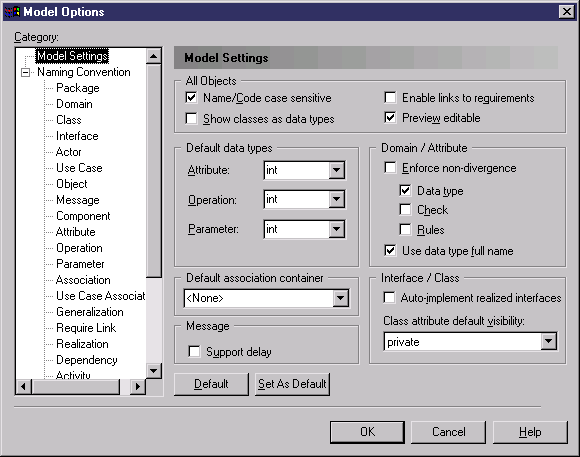You can set OOM model options by selecting or right-clicking the diagram background and selecting Model Options. These options affect all the objects in the model, including those already created.

You can set the following options:
|
Option |
Definition |
|---|---|
|
All Objects: Name/Code case sensitive |
You can define the case sensitivity of names and codes for all objects in the current model. When this check box is selected, it implies that you can have two objects with identical name or code but different case in the same namespace. Unlike other model options, you can modify the name and code case sensitivity during the design process. However, if you do so, make sure you run the check model feature to verify if the model does not contain any duplicate object. |
|
All Objects: Enable links to requirements |
Displays a Requirements tab in the property sheet of every object in the model. Requirements are descriptions of customer needs that must be satisfied during the development process, and are defined in requirements models. The Requirements tab allows you to attach requirements to objects in your model. These attached requirements are kept synchronized with your requirements model. For more information on requirements, see the Requirements Modeling guide. |
|
All Objects: Show classes as data types |
Includes classes of the model in the list of data types defined for attributes or parameters, and return types defined for operations. |
|
All Objects: Preview editable |
Applies to reverse engineering. You can edit your code from the Preview page of a class or an interface by selecting the Preview Editable check box. This allows you to reverse engineer changes applied to your code directly from the Preview page. |
|
Default Data Types |
Specifies default data types for attributes, operations, and parameters. If you type a data type value that does not exist in the BasicDataTypes and AdditionalDataTypes lists of the object language, then the value of the DefaultDataType entry is used. For more information on data types in the object language, see "Settings category" in the Resource Files and the Public Metamodel chapter of the Customizing and Extending PowerDesigner manual. |
|
Domain/Attribute: Enforce non-divergence |
|
|
Domain/Attribute: Use data type full name |
Specifies that the full data type name is used for attribute data types instead of its abbreviated from. Provides a clear persistent data type list for attributes. |
|
Default Association Container |
Specifies a default container for associations that have a role with a multiplicity greater than one. |
|
Message: Support delay |
Specifies that messages may have duration (slanted arrow message). If this option is deselected, messages are treated as instantaneous, or fast (horizontal message). |
|
Interface/Class: Auto-implement realized interfaces |
Adds to the realizing class any methods of a realized interface and its parents that are not already implemented by the class. The <<implement>> stereotype is applied to the methods. |
|
Interface/Class: |
Specifies the default visibility of class attributes. |